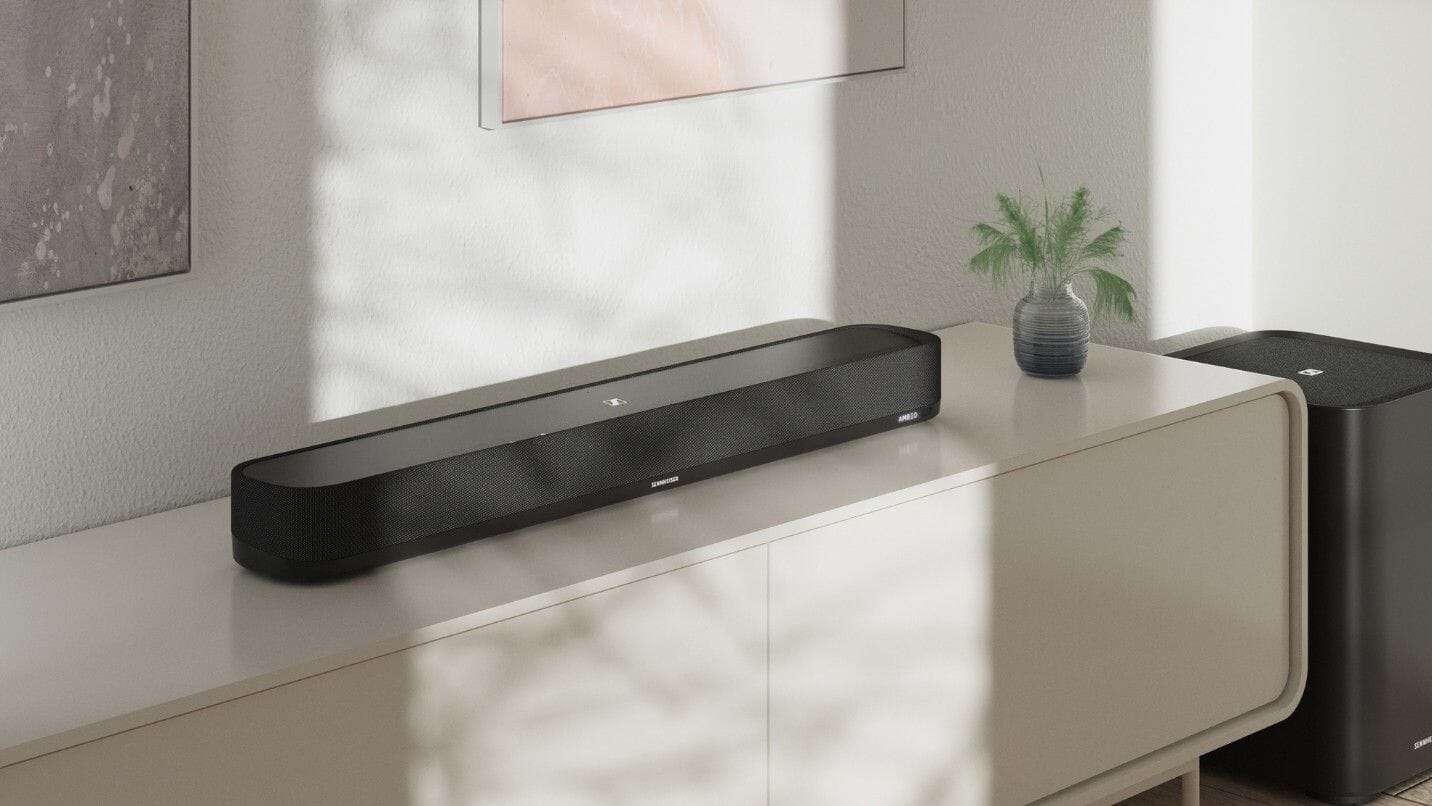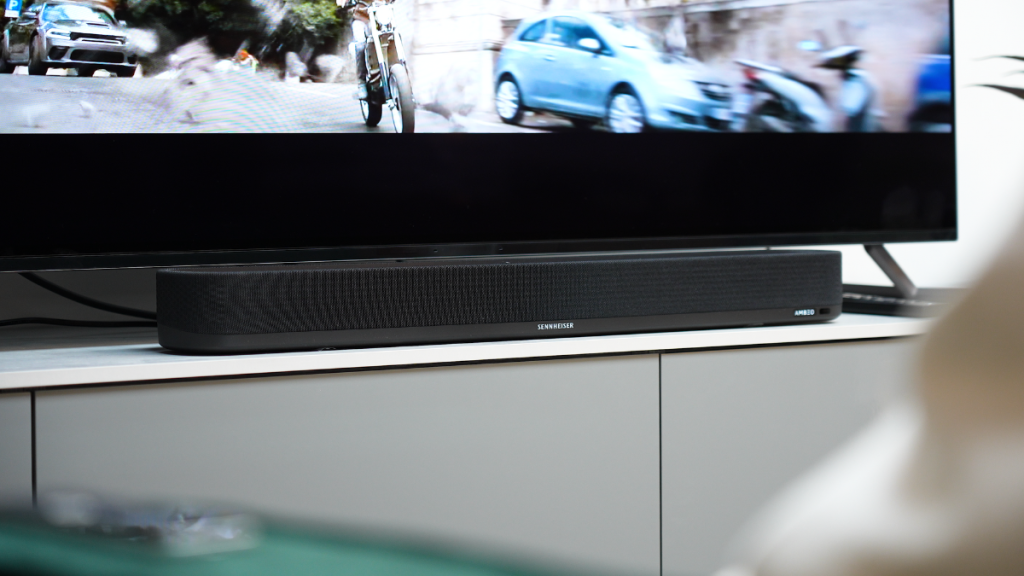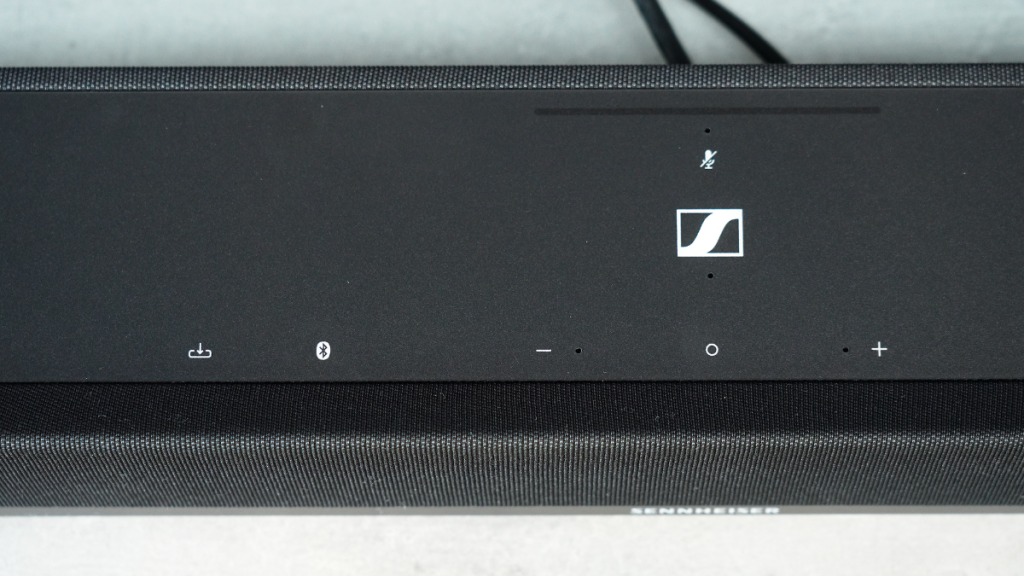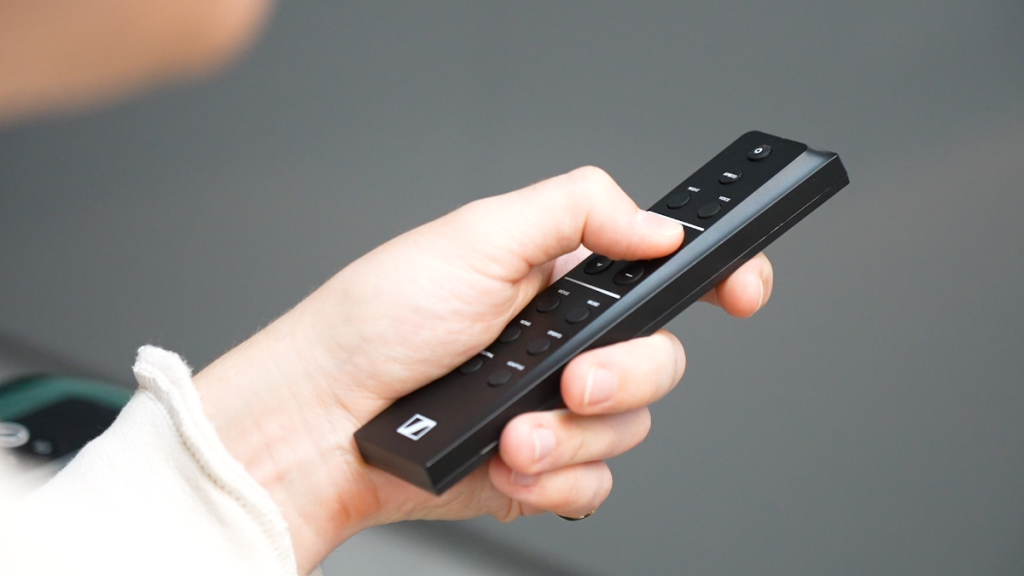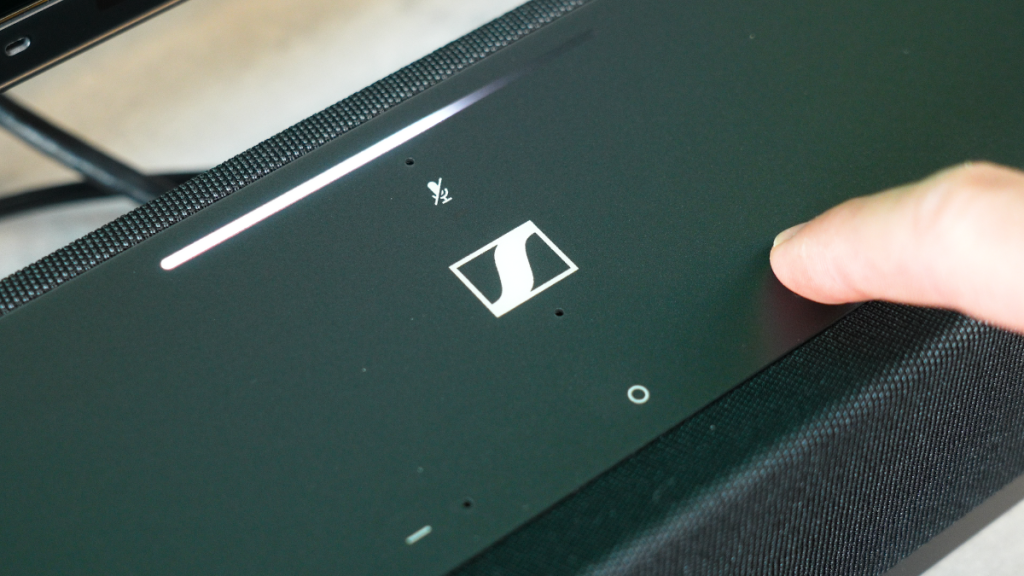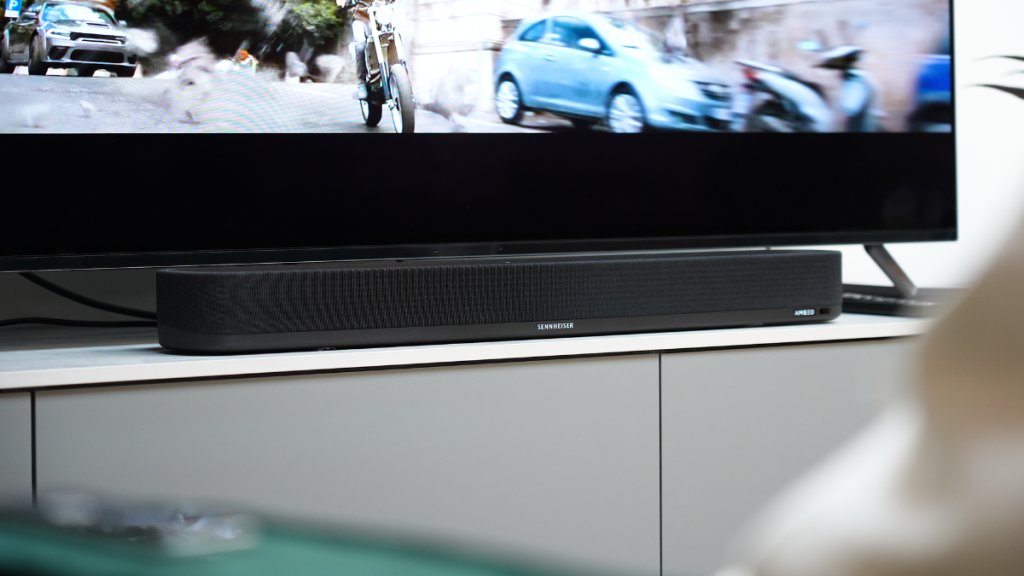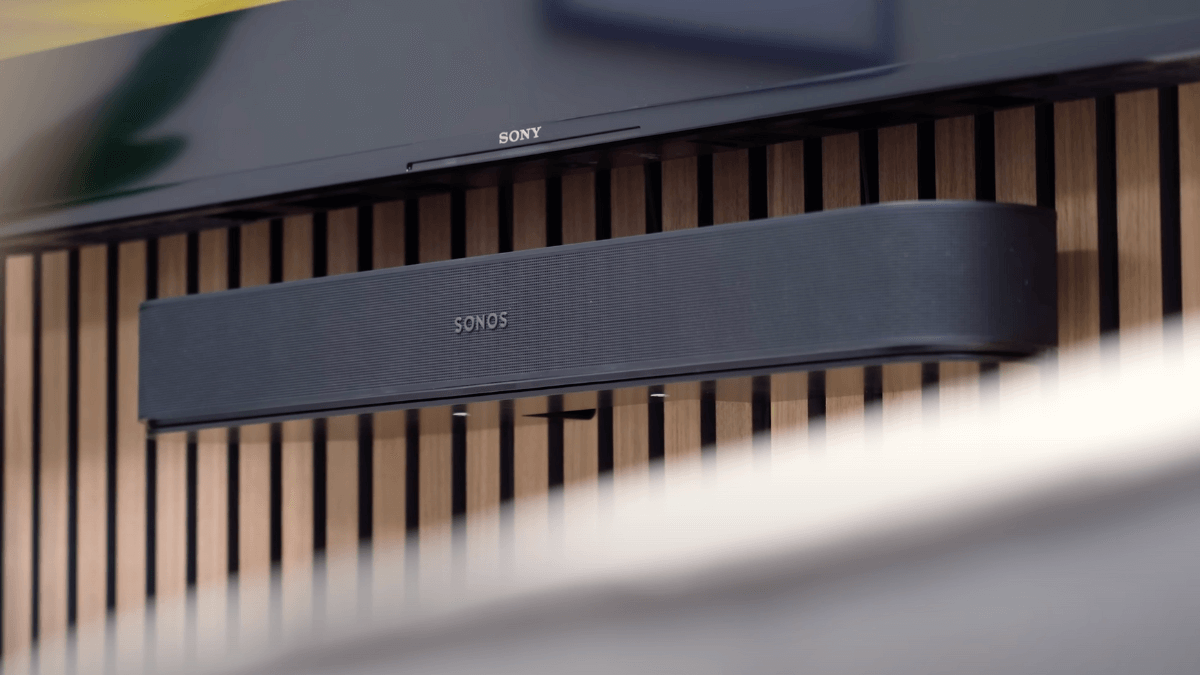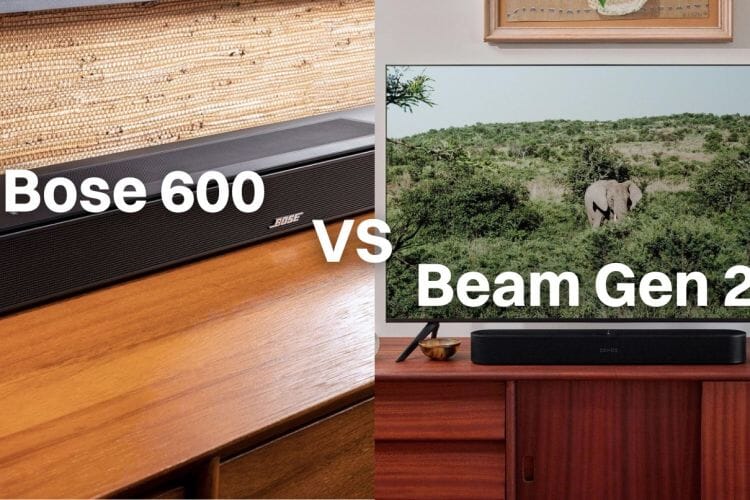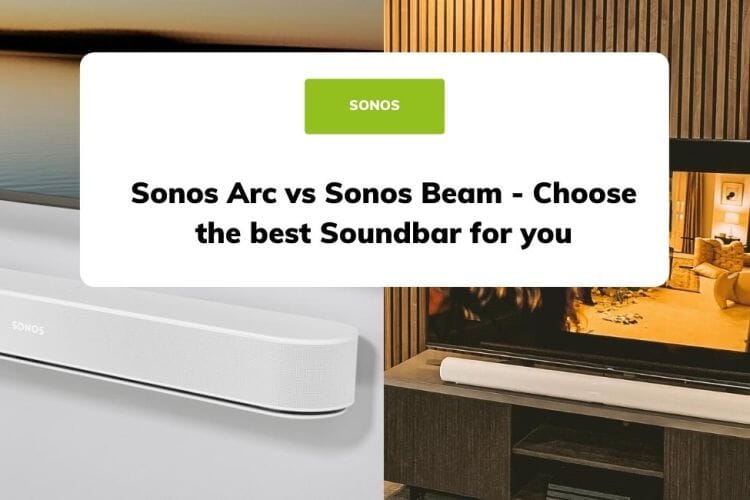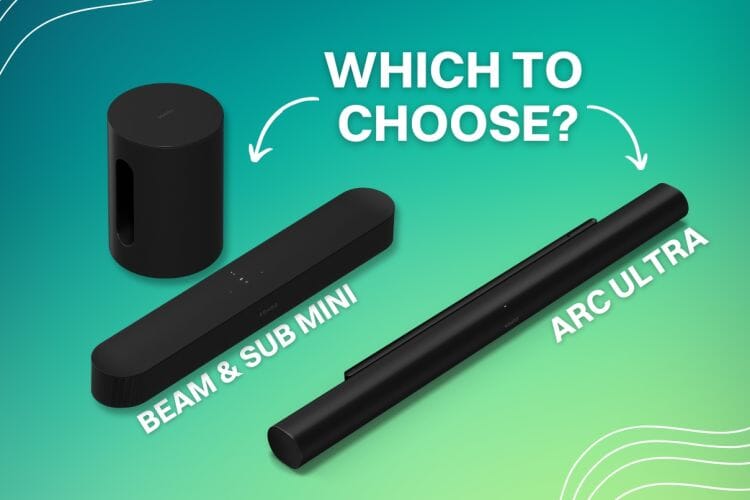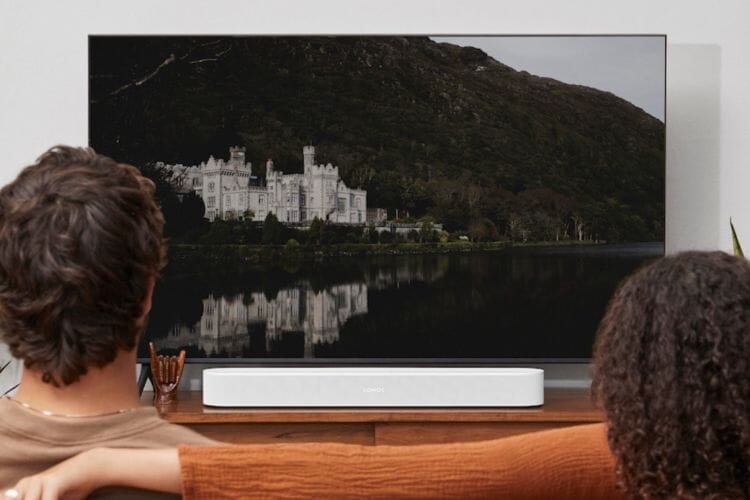sennheiser's small but mighty soundbar has arrived
Designed to bring signature Sennheiser sound to smaller spaces and bridge the gap in performance between the premium soundbars and the more compact rivals on the market right now, the Sennheiser Ambeo Soundbar Mini is set to be capable of competing with the very best compact Dolby Atmos soundbars out there.
However, with a high-end price tag of £699, throughout this review, we’ll be testing to see how this soundbar stacks up against the best-sellers in the compact Dolby Atmos category to see if it justifies your extra budget.
We’ve got absolutely no doubts that this feature-filled soundbar is going to shake up the playing field and push the compact Dolby Atmos soundbar category to new heights.
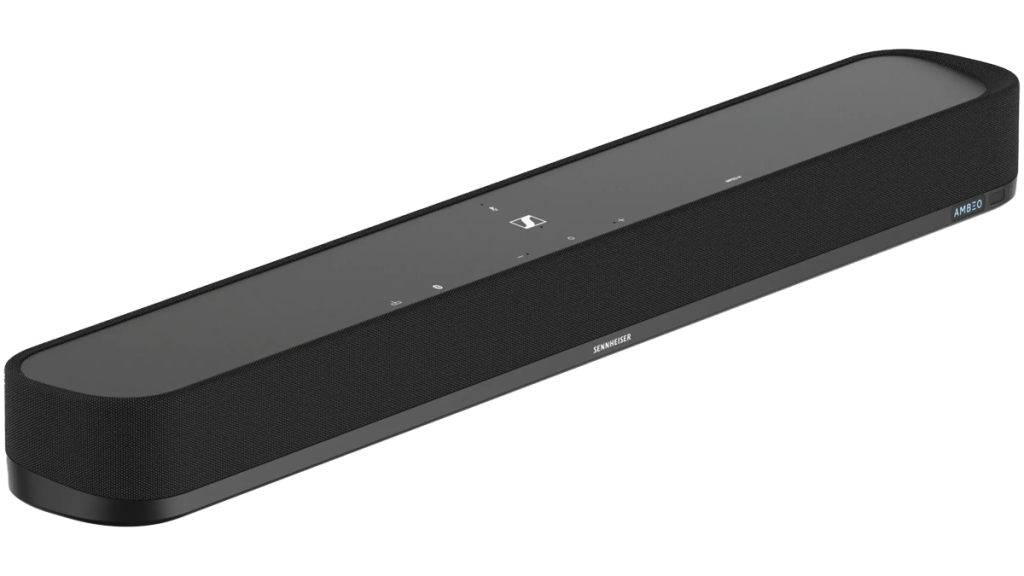
| Sennheiser Ambeo Soundbar Mini Price: £699 (See Latest Pricing) |
| Pros | Cons |
| ✅ Effective Ambeo virtualisation for atmos immersion ✅ Sleek, modern styling + premium build quality ✅ Intuitive app | ❌ Expensive compared to other compact options ❌ No option to add rears right now ❌ Lacking a bit of oomph in the low-end |
Why not check out our hands on Sennheiser Ambeo Soundbar Mini Review over on our YouTube channel?
Design
Physically, aside from the smaller form factor, the Ambeo Mini is pretty similar to its forebear, the Sennheiser Ambeo Plus, with its sleek plastic cabinet, fabric wraparound grille, and Ambeo LED detailing.
Tucked away on the base are some rubber feet that help to prevent any unwanted vibrations and provide some ventilation for the soundbar, while the angled top panel enhances usability and houses the controls.
Now, just like the Max and the Plus, the Sennheiser Ambeo Mini is only available in black, which doesn’t give you any choice when it comes to styling but will likely be the preferred colour choice for lots of you anyway.
Again, this top panel is almost a replica of the Ambeo Plus. You've got all of your touch controls and your ambeo mode toggle. You’ll also notice an active codec LED light, which we were huge fans of with the Ambeo Plus, so there’s no chance of any uncertainty about whether you’re actually listening to Dolby Atmos or not with this soundbar.
Admittedly, the Ambeo Mini does look slightly more like a conventional soundbar than some of the more lifestyle-focused brands like B&O or Sonos. But it’s still got that very robust and bold look that the Sennheiser Ambeo Max is renowned for without feeling quite as imposing.
Albeit a little bigger than something like the Sonos Beam (Gen 2) and slightly wider than the Samsung HW-S60B, the Ambeo Mini will still be ideal to sit under most TV’s, on top of almost any media unit, or even wall-mounted if that’s what you’re looking for.
| 💡SHS Top Tip💡: For some rough guidance, we tend to recommend these more compact soundbars for TV’s 55” and under. |
In terms of design, the Ambeo Mini ticks a lot of boxes. No, it's not particularly groundbreaking, but it’s practical, looks impressive, and sticks pretty true to Sennheiser’s design philosophy that we’ve seen throughout the rest of the range.
Connectivity
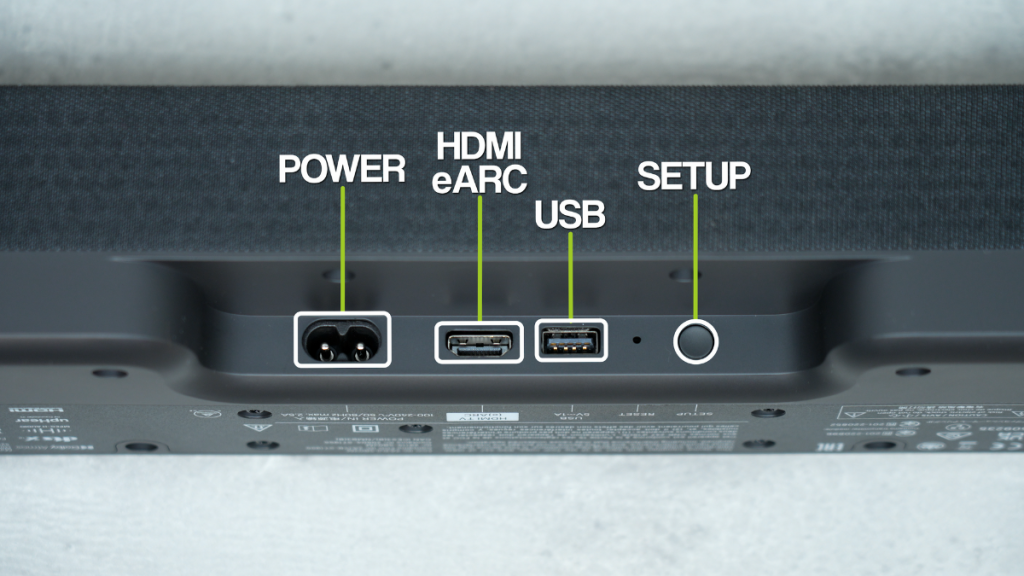
Sennheiser has opted for a much simpler “one cable” approach with the Ambeo Mini. Offering only an HDMI 2.1 eARC port, USB input, and mains power connection on the rear of the soundbar. We would’ve liked to have seen an extra HDMI 2.1 4K 120 Hz Passthrough port or two like we saw on the Ambeo Plus, especially at this price point. However, this is a trend we’re seeing more and more with premium soundbars at the moment, so it’s not too surprising.
You’ll also notice there’s no dedicated Sub Out either, so if you’re looking to add a wired subwoofer (which you can do on the Ambeo Plus and the Ambeo Max), this won’t be the one for you. That being said, you do have the option to add up to four of Sennheiser’s Ambeo Sub, which is more than enough in our book.
Connections aside, the Ambeo Mini still offers support for nearly every other audio codec you could wish for. There’s support for Dolby Atmos in its enhanced TrueHD format, DTS:X, Sony 360 Reality Audio, and MPEG-H. You’ll also benefit from Bluetooth 5.0 connectivity, which is a huge plus if you’re looking for a soundbar with lots of versatility. As well as the latest Wi-Fi streaming capabilities via all the major music services, like Spotify, Tidal Connect, Apple AirPlay 2, and Google Chromecast built-in.
Control
When it comes to control, you’ve got a variety of different options. There are your top panel controls we mentioned earlier, the Ambeo Soundbar Remote (which, yes, is a spitting image of what we’ve seen from the other Ambeo soundbars previously), voice control via either Amazon Alexa built-in, Google Assistant with Google Home, or Siri via Apple HomeKit, or you can use the Sennheiser Smart Control App (or web browser equivalent).
Sennheiser Smart Control App

The Sennheiser Smart Control App is intuitive, setup is seamless, and there are plenty of adjustments you can make to really make this soundbar your own.
You’ve got all the basics, like your integrated music player, input selection, and volume. There’s some adjustable EQ presets with dedicated sound modes like Adaptive, Movie, Music, Neutral, News, and Sports, which you can obviously fine-tune to your preferences with their dedicated EQ’s.
There’s also an option to adjust the Ambeo 3D Sound levels from a choice of Light, Regular, or Boost. From our testing, we’d suggest keeping this on regular, but boost does widen the soundstage, so if you’re looking for a broader and more expansive audio profile, this may be worth considering. There’s also a dedicated Night Mode that compresses the bass of the soundbar for more discreet listening at night, as well as Voice Enhancement, which improves the clarity of dialogue and vocals too.
Within the app, you’ll also find Sennheiser’s Ambeo Mode toggle. This essentially controls Sennheiser’s custom processing method, which looks to boost the performance of your soundbar by enhancing the overall effects of spatial and immersive audio.
It’s a pretty clever piece of tech that works alongside the likes of Dolby Atmos to add a boost in immersion and soundstage width, which might not be for everyone but is definitely something we'd recommend playing around with once you get this soundbar setup.
You’ll also find Sennheiser’s system calibration tool within the app, which is really impressive. This automatic equalisation software uses the Ambeo Mini’s four built-in mics to analyse the acoustics in your room and optimise its sound performance accordingly. It’s ridiculously quick and requires nothing from the user, and we’d go as far as to say it's one of the most seamless optimisation processes we’ve used.
There are also some more detailed enhancements like centre channel adjustments, codec settings, and LED brightness within the app, but the list isn’t endless, so you’re not going to need to spend too much time here. The app itself, though, is perfectly suited for its purpose. It's super simple to use and up there with some of the best for us. It’s been great to use on a daily basis and offers more than enough functionality to compete with some of the best on the market.
Internals
The Sennheiser Ambeo Mini comprises a total of six speakers, all driven by their own class-D amplifier. It includes two 1.6” full-range drivers projecting sound forward, another pair directing sound to the sides, and dual 4” woofers for deep bass that can go as low as 43 Hz.
Now, as with a lot of these compact soundbars nowadays, you’ll notice there are no dedicated upward-firing drivers. Instead, the Ambeo Mini uses virtual height speakers to simulate overhead effects. Technically speaking, that means this soundbar is still capable of delivering 7.1.4 ch surround sound; it’s just done using Sennheiser's acclaimed virtualisation technology.
In terms of processing power, by using the same quad-core processor as the Sennheiser Ambeo Plus, there’s no doubt this is a very capable soundbar that’s more than capable of handling whatever you choose to throw at it.
Sound performance
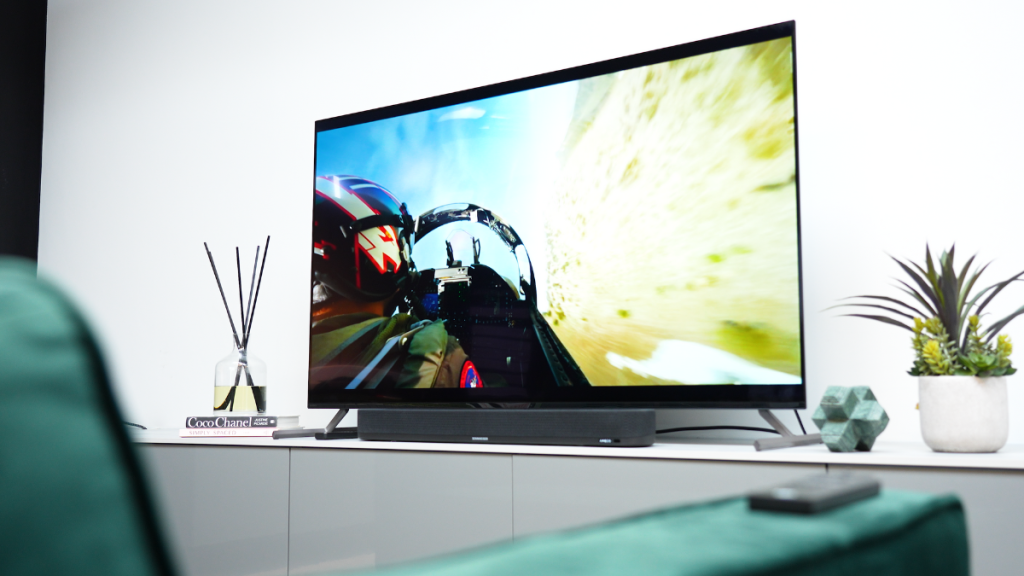
Don't let its size deceive you; the Sennheiser Ambeo Mini delivers an impressive performance for movies, TV, and music. It’s capable of pushing closer to the much larger and more premium soundbars on the market, which is really impressive considering its size and relative price point. Whether it was upmixing content or playing the latest Dolby Atmos titles, the immersion, the width of the soundstage, and the way audio was steered around the room have been exceptional.
From our testing, we’ve highlighted the four key takeaways that we’ve found when listening to this speaker on a day-to-day basis:
✔️ Immersive Atmos effects achieved with Ambeo virtualisation
✔️ Wide, room-filling soundstage
✔️ Impressive clarity and separation
✔️ Ambeo Mode delivers a spacious 3D sound
How a soundbar handles both Atmos and Non-Atmos content is equally important, and this soundbar excels in both departments. Thanks to Sennheiser's innovative Upmix Technology, both stereo and 5.1ch audio get an impressive boost in performance and ensure a more expansive and immersive experience regardless of what you’re watching.
Of course, there are no dedicated upward-firing drivers in this soundbar, and it doesn’t quite compete with a complete cinema setup or soundbar with dedicated height channels. However, what it can achieve with Ambeo Virtualisation Technology alone is still pretty impressive.
The soundstage was broad and room-filling, but the way the audio transcended from the front all the way to the back of the room aerially was thoroughly impressive and by far the standout feature.
Unfortunately, we weren’t quite as blown away by the bass performance of this soundbar. Naturally, as a smaller unit, we’re not expecting to get the booming bass that you get with the Ambeo Max or Plus, but it did feel as if we were left wanting a little bit more in the low-end now and again. For smaller spaces, it may not be quite as noticeable, but we did miss that subtle rumble at higher and lower volumes.
Of course, there’s always the option to pair up to four Ambeo Sub’s, but that’s an additional £649 each, which might not be something you’ve factored in. Sennheiser currently doesn't offer support for any surround sound rears either, which would’ve been a great upgrade later down the line if you were after total immersion or that authentic 360º soundscape.
So, for those looking for a more all-encompassing experience, you might prefer a setup with dedicated surround sound rears. We’re hoping this is something on Sennheiser’s radar for the future, and the rumours have already started, but for those shopping around right now, it’s something to bear in mind.
Music Listening
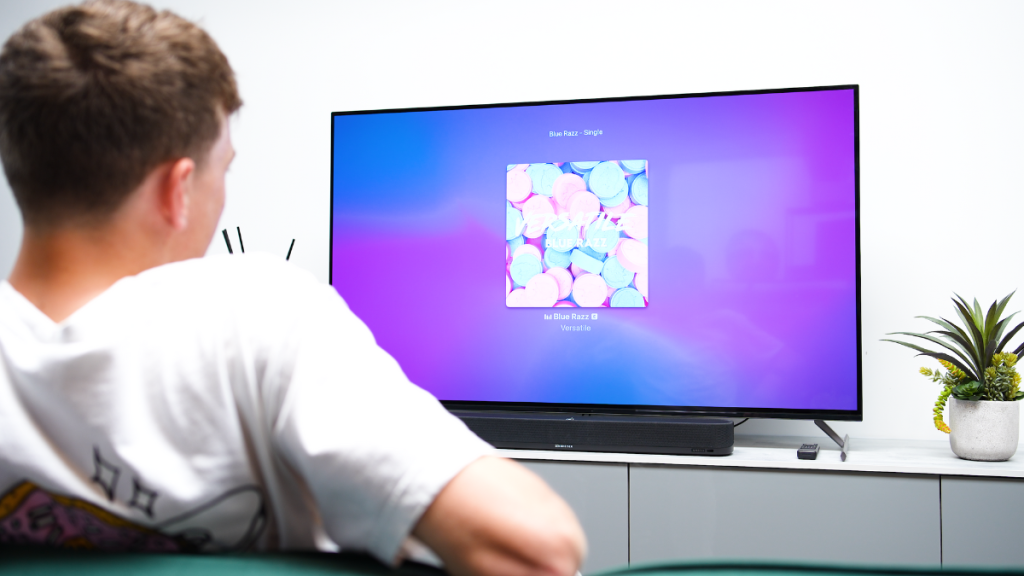
Now, moving away from film and TV, It’s worth focusing on the music listening experience from this soundbar too, because this is a very musical soundbar. In our testing, it handled everything we had to throw at it really well. Every genre and track was dealt with with ease, and it was everything you’d expect from a Sennheiser product.
The midrange details in tracks like “Where I Find My Mind” by Eli & Fur were brilliant. The separation was excellent too, and even really complex Dolby Atmos tracks like “Militerian” by J-Hus never felt muddy. Again, the bass probably could benefit from a little boost here, but the vocals were great, and there's always the option for a subwoofer if you’ve got the budget.
Ambeo Mode
One of the staple features of Sennheiser’s soundbar range is their AMBEO mode. We’ve had a bit of a love-hate relationship in the past with this feature, but we actually think it plays into the strengths of the Ambeo Mini.
There’s still a catch-22 to be had, whereby you’re sacrificing lively and expansive audio with Ambeo Mode on for more natural dialogue and clarity when it's off. But the difference is less noticeable than what we found with the Ambeo Plus.
Yes, there’s definitely a time for it to be on and off, and there’s room for a little more consistency in vocal clarity regardless, but you also have that voice enhancement toggle in the app, which did a great job at picking up a bit of the slack in this department.
As a general rule of thumb, if you’re all about clarity in dialogue, voice enhancement is probably worth keeping on the majority of the time, but ultimately this will come down to how you enjoy listening. It’s great to have options nonetheless, but it’s worth testing them all out for yourself to find what really works for you.
Sennheiser Ambeo Mini Vs Sonos Beam (Gen 2)
Based on our testing experiences, it’s clear that both of these soundbars are the front-runners in the market; however, there is a considerable difference in their prices. The Ambeo Mini’s Dolby Atmos handling is better than the Sonos Beam (Gen 2), and it also offers a wider soundstage with more precise details and separation. However, the Beam offers low-end and vocal performances that are almost impossible to beat in this category, making this comparison much tighter than expected.
The Ambeo Mini does offer more versatile connectivity with the option of Bluetooth and DTS:X (two things we know the Sonos community would love to see on the Beam). However, the Sonos ecosystem is arguably the best there is. Not only will you benefit from the flexibility to connect to Sonos speakers all over your home, but you can also add a subwoofer and rear surround speakers wirelessly. So, for those who want their soundbar to be the starting point for a full home cinema setup, the Beam seems like the smarter choice.
All in all, these two soundbars are both exceptional options, and it’s great that we do have choice in this category. Would we say that the Sennheiser Ambeo Mini is £200 better than the Beam? For the right person, yes. For others, no. It will just all depend on your non-negotiables and listening preferences.
Our Verdict
The Sennheiser Ambeo Mini is a soundbar that’s designed to sit in that sweet spot of performance, price, and form factor. Not only is it wonderfully simple to use, but It's built to be fit into almost any space and delivers a sound performance that’s more than capable of filling a larger environment if needed. It gives a clean, powerful, and immersive performance that truly comes alive with Atmos content and outperformed its spec sheet and form for me.
As a standalone soundbar, we think this has taken the crown as the best premium compact Dolby Atmos soundbar (albeit at a premium price). Yes, it’s got its pros and cons, and for some people, something like the Sonos Beam (Gen 2) might be a better investment for you and your space, but for those who do opt for the Ambeo Mini, you’re going to thoroughly enjoy it.
Other uSeful Content
Video: Sonos Beam (Gen 2) Review; What Have They Done?!
Video: Sennheiser Ambeo Plus: The Ultimate Dolby Atmos Soundbar?
Blog: Sonos Arc Review: Is It Worth It In 2023?
Blog: Sonos Ray vs. Sonos Beam Gen 2 vs. Sonos Arc: How to decide
We hope you find this helpful, but if you have any more questions we are more than happy to assist with any queries you may have.
Please reach out on:
| info@smarthomesounds.co.uk | |
| Live Chat on our Website | |
| 0800 677 1100 |


